Market Breadth using the New High New Low ratio and the Cumulative Advance Decline line for the NYSE and NASDAQ.
I’ll let the charts do the talking…
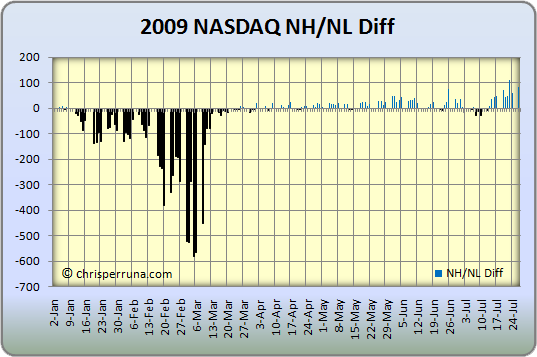
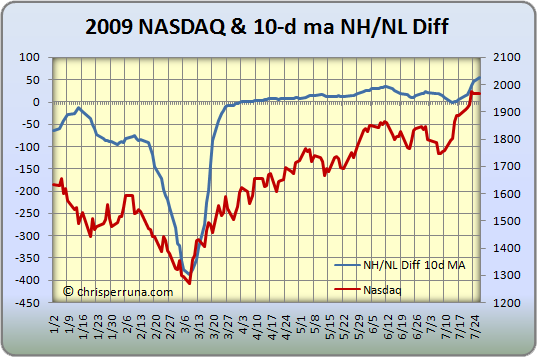
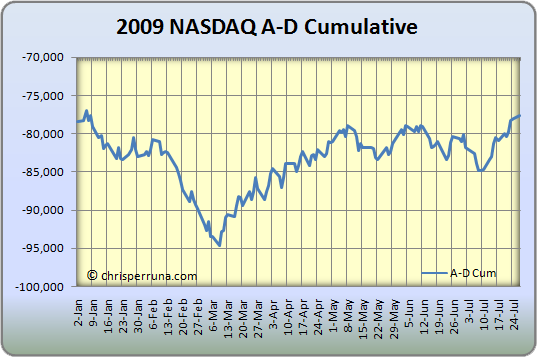
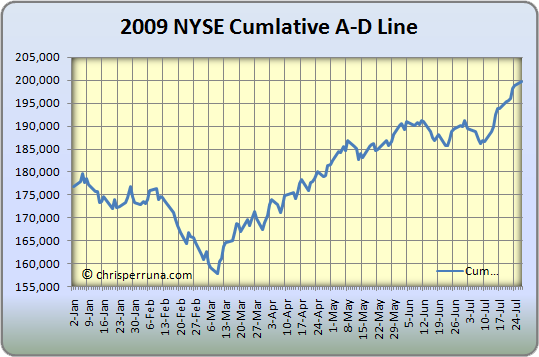
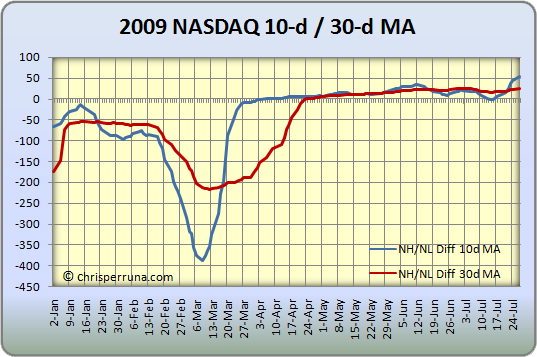
A blog about trading, finances, success and life itself
Market Breadth using the New High New Low ratio and the Cumulative Advance Decline line for the NYSE and NASDAQ.
I’ll let the charts do the talking…





I am once again focusing my energy on the New High New Low (NH/NL) data as it is historically the most accurate indicator in the market. No indicator is as valuable as this tool. What I have done today is charted the 10-d/30-d MA Diff to show you a major crossover that occurred in March 2009. The exact date of the crossover was March 18, 2009; the NASDAQ is actually up more than 26% since that day. Not a bad trading strategy but I will admit it’s not one that comes around often. The second and third charts show the NH/NL differential and the NH/NL 10-d ma diff.
As I said in the post NH NL Picks Market Tops and Bottoms:
Consistent Nasdaq readings above 100-200+ will be the official confirmation to grab and add shares for trend traders!
That’s what I am looking for! Until that happens, a “true” up-trend is not sustainable. The up and down whipsawing of the past several month is what we can continue to expect until we see consistent readings in the triple digits.



Do you really want to know how to pick market tops and bottoms? Really?
Well, you don’t need a crystal ball, you don’t need any Wall Street guru’s, you certainly don’t need fancy computer software and you can simply ignore the talking heads. It’s that easy. Maybe we won’t pick absolute tops and bottoms but we can identify trends as they begin to develop.
You just need to follow the action among the individual stocks in the market! Learn to focus on the number of stocks making new highs versus the number of stocks making new lows. It’s been the true crystal ball in my method since I started to turn a consistent profit in 2002. It’s the backbone of my trend following methods.
The NH-NL Differential is simply the number of stocks making new highs minus the number of stocks making new lows.
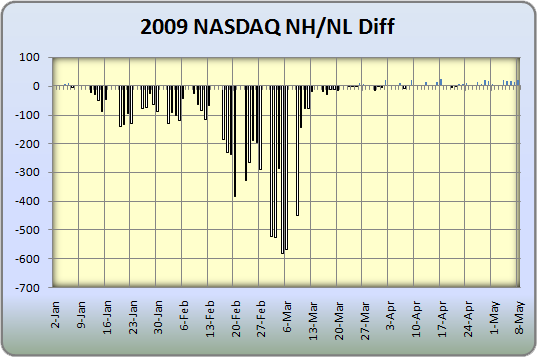
I follow the progress of stocks making new highs and new lows on the NASDAQ and NYSE and pay specific attention to turning points in the differential. I am not so interested in the extreme highs or lows of the ratio but rather changes in trend from positive to negative and negative to positive over a period of time.
The yearly Nasdaq New Highs and New Lows (Differential) are captured in my charts below, dating back 10 years. With many market pundits (or talking heads) saying that we may have reached a bottom, I felt it was time to do some homework and study the past charts so we know what to look for in 2009. It is true that the trend seems to be changing but we aren’t quite there yet. Focus on 2002 and 2003 to get an idea of what we may see if this market decides to make a true up-trending run, one that’s sustainable.
Consistent Nasdaq readings above 100-200+ will be the official confirmation to grab and add shares for trend traders!
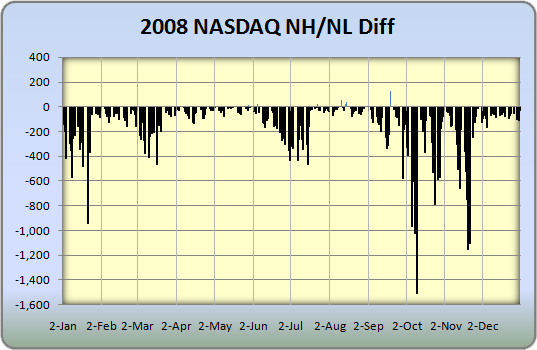
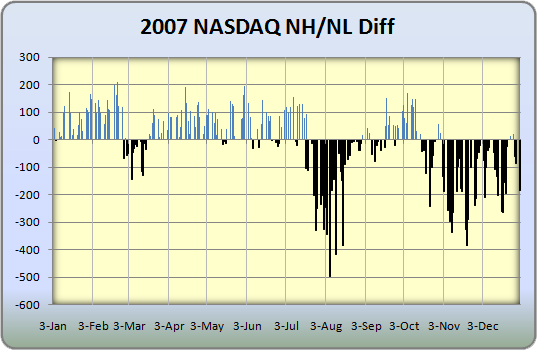
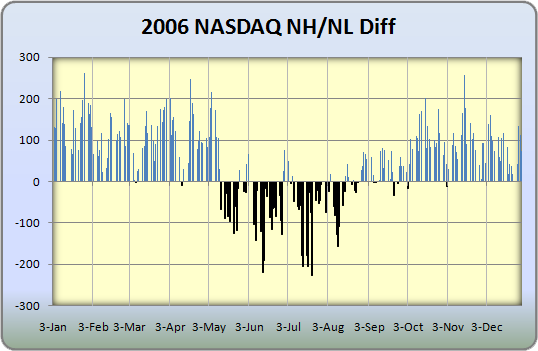
Every once in a while you like to look back and review your notes to locate where your research was right and where it was wrong. The simple technique of following stock market leaders and the NH-NL ratio nailed the period of time when the market transitioned from an up-trend to churning to the “Big Decline”. We nailed it here on this blog and every reader was prepared for the imminent decline. No one can dispute that. Readers of this blog were told to move to cash to preserve capital in late 2007 and early 2008. Now, I am not talking about day traders but longer term traders or investors that work full time and do what I do.
The chart highlights in red where I was making the sell posts (the articles are listed below):
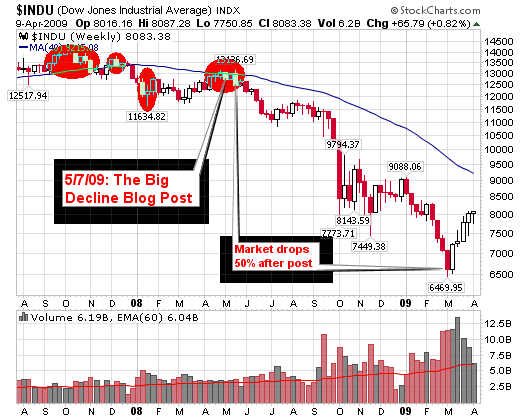
Anyway, I have been posting twits about the strengthening of the NH-NL ratio which is starting to tell me that the newest trend change is beginning. Yes, this is my first major blog post saying that my screens (market tools) are telling me to wake up because things are starting to change. It’s not time to jump in with both feet and buy every stock that’s up on above average volume but it’s time to sharpen the skills and be ready. We may look back and point to March and April of 2009 as the bottom of the market or at least the start of the changing trend.
We don’t have market leaders yet but when they appear, I will locate them, post up charts and talk about them nightly on twitter (twitter.com/cperruna). Too many stocks still have their 50-d moving averages below their longer term 200-d moving averages and new highs are still limited. However, new lows have dried up considerably and the NH-NL ratio has a moving average that is trending higher for about a month now. That’s the most sustainable trend for this ratio since the big decline started.
Stay tuned to the blog and my twits for follow-ups to my research on individual stocks and the overall trend.
In the meantime, take a look back at the numerous blog articles I posted in 2007and 2008 talking about a market decline, shorting stocks and selling in general. Learn from what the simple tools were telling us. I am far from a market genius and far from rich but I can make a few dollars following the leaders and the NH-NL ratio.
A Review of Articles Pointing to a Stock Market Decline in early 2008:
The bottom line or point of today’s rant is the fact that I still feel that the market is headed for a decline or as I phrased it a couple weeks ago: The Big Decline (long term perspective of course).
I originally started to point out market troubles back on March 14, 2008 in a post titled Snapshot Friday; I highlighted both the Dow Jones and NASDAQ with clear yellow shaded areas showing the 200-day moving averages pointing down for the first time since 2003 (that’s huge if you ask me).
I am a positive person by nature and I prefer to buy stocks going up but I am starting to see several leading stocks struggle to hold new highs or fail to challenge recent highs. These patterns are familiar and they are suggesting that the recent bounce is the final stage before a possible market decline.
I wrote an article on October 15, 2007 titled How to Make Money Selling Short, precisely when the general market indexes were topping. I am not going to take full credit but subconsciously my charts were giving me signals that the market was showing the major red flags and signals of what we are seeing today.
A Review of Articles Talking about Selling, Profit Taking and Market Distribution in late 2007:
Well, the current two year rise of the Shanghai Stock Exchange Composite Index looks remarkably similar to the rise of the NASDAQ of the late 1990’s and the charts below explain better than I can!
What do you do in a market like today when you have profits in multiple positions but you don’t want to give it all back? You want to continue to ride the winners but at the same time, you want to maintain the unrealized gains in your account. HOW?
This was the largest showing of volume in two months and is not healthy because it was pure distribution. It was only the second distribution day over the past month so we can’t call this a bear run but please be on the lookout for a possible correction of 5%-10%. Technology stocks led the decline as BIDU gave back 10% of its amazing run.
This chart explains what I have been talking about on twitter.
Follow my nightly tweets at twitter.com/cperruna.
As I said in a recent response to a blog comment by Jeff: “The NH-NL ratio is showing some up-tick from the brutal beating it has taken recently. A positive shift will peak my interest. Not there yet.” I am keeping better watch lists because of the slow trend change in the chart below. We have a ways to go before we can start buying shares but very subtle changes are taking place.
Recent Tweets:

*Chart courtesy of DecisionPoint.com

Born and raised in New York but now living in New Jersey with a beautiful & loving wife, and two fantastic kids (boy and a girl). This site is about the stock market, success and life … [Read More...]
Copyright © 2025 on Genesis Framework · WordPress · Log in
Connect with Me